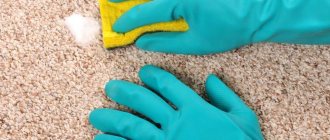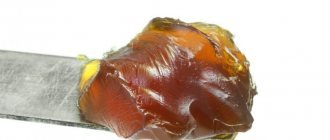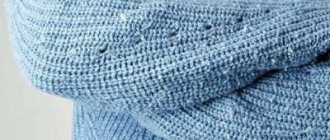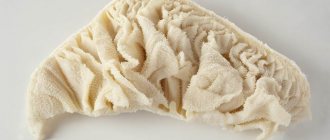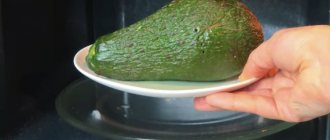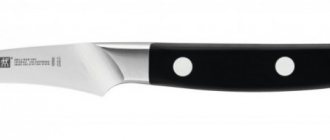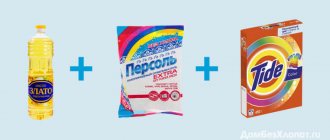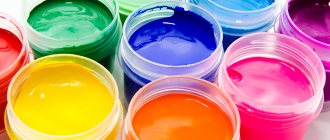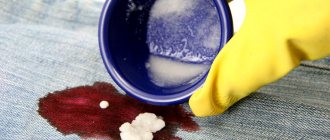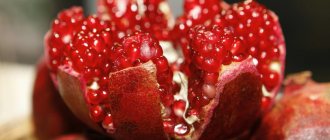Hi all!
There are days when everything seems to happen out of spite! Such an annoying chain of events: in the morning you burn yourself on a frying pan, you lose your keys, the dog chewed your favorite shoes, and after experiencing stress you want to drink a glass of tomato juice and inadvertently spill it on your favorite jumper.
Such unpleasant days come and, unfortunately, nothing can be done about it, but you have to deal with the consequences. I can’t help with the dog and shoes, but I’ll tell you how to remove tomato juice from your favorite thing.
First aid for a fresh stain
If you just spilled a tomato drink on yourself, don't waste your time. It is best to sprinkle a fresh stain with salt. It will absorb any remaining liquid, making it easier to remove traces of juice. This method is not only suitable for tomato stains. You can use the method to remove contaminants from fatty broths, as well as beets.
Another way to help save fabric is regular laundry soap. To remove as much dirt as possible from the fabric fibers, scrub the dirt with a brush. Movements should be from the edge of the spot to the center.
Important! The brush should not be used on delicate fabrics. For example, wool and silk.
Specialty Chemistry
Professional tools will help you:
- liquid or powder stain remover;
- soap for removing stains (preferably after pre-treatment with another solvent composition);
- bleaching washing powder (for white only).
To choose the optimal product, pay attention to marks like “for colored”, “for white”, “for delicate fabrics”. If you are removing a stain from silk or wool, you should play it safe and re-read the label. On aggressive products there is a marker like “do not use for delicates.”
Before using products, you should check the label on your clothing . Delicate and delicate fabrics will not withstand exposure to chlorine-containing products. It is also important to observe the temperature regime recommended by the manufacturer. Do not expose the entire product to the product; local cleaning is suitable for most cases. When using potent compounds, do not forget to wear rubber gloves and ventilate the room. After cleaning, rinse the fabric thoroughly and proceed to standard machine wash.
Effective Methods for Removing Tough Stains
There are several effective ways to help deal with difficult tomato juice stains:
1. Washing powder . This method is great for synthetic fabrics. You need to prepare a concentrated solution of powder and water. It is then applied to the material. You need to let it sit for half an hour, and then rinse the clothes thoroughly. Afterwards you can wash the fabric in the washing machine.
2. Laundry soap. If the stain is several days old, it can still be removed with regular soap. Contaminants are removed thanks to the acids that are part of the bar. It is necessary to thoroughly soap the stain and leave for 30 minutes. Then you can wash your clothes as usual.
3. Antipyatin. This is a special soap that cleans different types of fabrics well. It is suitable for different materials. Antipyatin's biggest advantage is hypoallergenicity. This product is suitable for washing baby clothes.
4. Stain remover. It effectively fights any pollution. The product is very concentrated, so it can ruin clothes. Be sure to select a stain remover based on the type of fabric. Particularly strong are stain removers such as Vanish, Amway, Faberlic.
5. Bleach. This product is only suitable for white items. It is advisable to use bleach for cotton or linen. Delicate fabrics require more gentle products.
If none of the above methods have dealt with the stain, you can use folk remedies.
General rules for deriving consequences
Of all vegetable juices, tomato is considered the most difficult to excrete. If you bought a package of reconstituted juice, it will be easier to deal with stains, but you will have to try harder with freshly squeezed juice. The success of the wash also depends on the naturalness of the juice and the fruit part/water ratio (for reconstituted juice).
If the affected area is large and the juice is quite concentrated, then you should not rub the stain with ordinary soap. Most often, this approach will only fix the dye to the surface.
Remember the first rule: do not let the juice dry out , because old stains are harder to remove and there is a high chance of failure. If you just spilled juice, quickly blot up the excess before it is absorbed deeply into the structure. A napkin or paper towel is suitable for these purposes. Gently blot marks, do not rub or smudge. It is worth cleaning off the excess from the edge to the middle so as not to inadvertently increase the damage caused.
Be sure to check the label before cleaning. Follow the manufacturer's directions and do not exceed the recommended temperature. Be sure to check compatibility with cleaning products, as many items cannot be cleaned with chlorine or bleach products.
It is worth exposing the item to cleaning agents only locally. There is no need to soak entire clothes in the product if you have a small stain. The only exception is that the packaging of the cleaning composition states that the items must be soaked completely, which is extremely rare.
Please note that there is no point in deliberately prolonging the chemical effect on the fabric. Thin and delicate materials from prolonged use of potent chemicals can deteriorate or develop bald spots - the chemicals will corrode the material. It is advisable to line the inside with a paper napkin or soft white cloth. As it soaks, replace it with a new one to quickly remove the coloring pigment.
Proven methods for combating pollution
Fruits and vegetables can be used not only for salads, but also as a stain remover. Cotton and linen can be cleaned well with lemon juice. You can use citric acid granules, but it is best to use the fruit itself. The fruit juice is squeezed onto a cloth. After 5 minutes have passed, you need to wash the fabric.
Acids penetrate deeply into matter, corroding contaminants. But you need to use this method carefully. Lemon juice may damage the material if left too long. The method is not suitable for silk! How to wash silk, see here;
You can also use fresh milk. To do this, you just need to soak the fabric. There is no need to wait for a certain time - milk does not harm the structure of the fabric fibers.
Interesting fact! Tomatoes help deal with tomato juice stains. Only green vegetables should be used. Tomato juice is squeezed onto the cloth. Then you need to rub the stain vigorously. After the mark has faded, you should sprinkle the area of the material with talcum powder and wash the item.
Another proven method is oxalic acid. Two grams of the product are diluted in 200 ml of water. You need to place a piece of fabric under your clothes. It is best to use white cotton fabric. Afterwards, the area is wiped with a cotton pad previously soaked in a solution of oxalic acid. Then you should wash the fabric.
Vinegar is also suitable for cotton. Dilute it with water in equal proportions and soak the clothes for two hours. Then wash the item with conditioner and dry it in fresh air to get rid of the unpleasant odor. For greater effect, you can mix the vinegar solution with the juice of half a lemon.
For white clothes, use hydrogen peroxide. Apply the mixture to a cotton pad and treat the stain. Move from the edges to the center so that it does not spread. Rinse the product in warm water. You can mix peroxide with baking soda and leave for five to ten minutes, then wash the item using the usual method.
Woolen items can be washed with mineral water. Soak the fabric in this drink and wipe away any stains with a cotton pad.
General recommendations
Several conditions must be observed to remove tomato stains. These include:
- Timeliness - the older the stain, the more difficult it is to remove. Already ten days of stains affect the structure of the fabric, so there is a greater chance of removing a fresh stain without losing the quality of the item;
- You should never put items with such contaminants in the washing machine. Be sure to wash everything by hand using appropriate products;
- You need to wash off the stain from the edges to the center, collecting dirt, and not rubbing it even more over the entire surface;
- You need to be careful when using acids to remove stains from colored clothing. Most of them are still intended for light-colored things, more often white;
- When treating contaminants, it is better to place clothes on a hard surface, placing an old cloth under it. Stains will be removed, and the rag will absorb dissolved dirt.
How to remove stains with alcohol
Medical alcohol or ammonia can remove stains. In the first case, mix a teaspoon of medical alcohol and salt. Actively rub the resulting pulp into the contaminated area and leave for forty minutes. Then remove the product with a brush and wash as usual.
In addition, you can first rub salt into the affected area, moisten it lightly with water and leave for half an hour. Then remove the residue with a cotton pad soaked in ammonia and wash the items. Ammonia or ammonia creates an alkaline environment that will help remove the bright color of the tomato stain.
Ammonia or ammonia cannot be used for colored items, as they may fade! It is advisable to wear gloves when using this product. To process, dilute ammonia in the proportion of one teaspoon of alcohol per glass of water and soak the item in the resulting solution.
Alternatively, apply undissolved ammonia to a cotton pad and gently treat the contaminated area. After the procedures, wash the items in the washing machine, rinse and leave the items to air to get rid of the smell.
You can dilute medical alcohol with glycerin in a ratio of 1 to 4. Apply the solution to the stain and leave for four hours. After this, we wash the items in the washing machine with a suitable washing powder or gel. By the way, ammonia and glycerin also remove stains from other vegetables, fruits and berries, for example, watermelon or pomegranate.
Can a tomato be washed?
Knowing how to properly remove a tomato stain at home, you can be sure of saving your favorite thing. Like any other natural dye, tomato juice is a difficult-to-remove stain. To remove it effectively and quickly, you need to know about some nuances:
- Once a tomato print appears, you need to wash it off immediately. It is best to use soap and a toothbrush, which can remove as many tomato particles as possible.
- Fresh or old dirt cannot be treated with hot water. When natural dyes are exposed to boiling water, they are absorbed even more thoroughly into the structure of the fabric.
- Before washing a tomato from clothes, you need to soak the item in a soapy solution. This is true for old stains. The minimum soaking time is 30 minutes.
Recommended reading: Benefits of tomatoes for the body
What to do
It’s good if the contamination is noticed right away - a fresh stain is much easier to deal with than an old one.
The main thing is to act quickly.
Powders
Stain removers
But if you didn’t immediately see the dirt or you simply didn’t have time to clean your clothes immediately, and the stains have already dried, special chemicals designed to remove old stains will come to the rescue.
Stain removers are now available in the form of a gel, powder, spray, roller or stick. There are quite effective products from Russian and foreign manufacturers. Their main drawback is that colored items can “fading,” even if the packaging says “for colored laundry” or “gentle formula to protect color.”
Therefore, you must first apply the product to an invisible part of the product, for example, the inside of a pocket or collar, the back seam, and leave for half an hour to act. Then wash the area and dry with a towel. If the paint is not damaged, no streaks or stains have appeared, then the product can be applied to the contaminated area.
You should not extend the exposure time of cleaning agents by several hours, as this may damage the structure of the fibers and make the fabric less durable.
Also, stain removers with a special brush applicator have recently appeared on sale, with which you can apply the product to the fabric for impact, and then gently clean off all the dirt. Typically, such products should not be used to clean silk and wool clothing. For them, you can try more gentle folk methods - mineral water, milk.
Bleaches
We are talking about soft oxygen products that do not contain chlorine. They also need to be used either only on white fabrics or after making sure they will not damage the paint.
Preparing for washing
We said earlier that preparing soiled clothes for washing is an important process that should not be skipped. In pursuit of saving time, we can send the item to the wash in the hope that traces of the tomato will disappear thanks to the powder. But such a rash decision will lead to the fact that the vegetable juice will adhere to the fabric and it will not be possible to remove it without damaging the tissue.
Therefore, to remove a tomato stain correctly, follow these tips::
- Speed of action . If you notice traces of juice on your clothes, proceed to cleaning immediately, since dried stains may require more aggressive treatment, which the fabric will not tolerate.
- Forget about the typewriter . If the traces are fresh, carefully clean the dirt with a brush, trying to remove particles of the vegetable. Then the washing is done manually and only then in an automatic machine.
- Precautionary measures . To prevent the stain from spreading over the area, place a napkin or towel under the item and the stained area. The contamination itself is cleaned from the periphery to the center, trying not to rub.
- Chemicals or improvised means . When choosing between aggressive substances and gentle compounds, consider the type of fabric, because the wrong product can ruin the item forever.
Why is tomato juice dangerous?
Tomato fruits contain a special coloring substance of the carotenoid family - lycopene. Carotenoids are responsible for the bright (yellow, orange, red) color of many vegetables, fruits and flowers - carrots, tomatoes, pumpkins, peppers. Lycopene is insoluble in water.
For this reason, stains on fabric from any tomato derivatives, be it tomato paste, juice, ketchup or sauce, are quite difficult to remove. And it is tomato juice that is the most harmless of those listed, since, unlike sauce, it contains no fat.
In any case, do not despair, some practical tips will help you save your favorite thing.
Verdict
If an expensive item or item marked “dry clean only” or “do not wash” (icon with a crossed out container of water) has been damaged by tomato juice, contact a dry cleaner . You should resort to home methods only with confidence in the result or with the awareness that the thing can be irrevocably ruined.
Important: dry cleaning employees do not accept items after home cleaning with stain removers.
If strong specialized chemistry is powerless, then it is unlikely that anything will have a positive effect on the stain.
Basic rules for removing tomato stains
Timely cleaning of clothes will keep them new
A number of special rules will allow you to remove stubborn tomato stains on a T-shirt, jeans or any other white and colored knitwear, including delicate fabrics:
- Timeliness is the main condition for washing. The longer you delay the procedure, the more difficult it is to remove stains. It is impossible to remove stains that appeared more than a week ago without damaging the tissue structure.
- You should not wash clothes with a tomato stain in the machine. Pre-wash it by hand using available products.
- Treat contamination from the edges to the center so as not to increase the amount of work.
- Soak old stains in laundry soap or prepared solution for 30 minutes. Finally, wash with additional detergent or soap.
- If you are treating the stain on a table, place a kitchen towel under your dress or shirt. It will absorb the dripping dissolved tomato.
A special feature of tomato juice is its ability to color fabrics. A permanent stain forms when the pigment is absorbed into the structure of the material, making it impossible to remove the red tint. This is the main reason why timely washing is required to achieve results.
Professional products
It is advisable to treat the contaminated area from the wrong side. In addition, a multi-layer paper towel or a white napkin is placed under the material, which is folded a couple of times.
This way the contamination will not spread further along the shirt. When working with stain remover, use a white cloth or cotton swab. The use of chemicals provokes shedding and worsens the problem.
In addition to cotton swabs, ammonia and peroxide, the following will help in resisting pollution:
When using stain removers, carefully study the composition and action. It should match the type and color of fabrics. Do not use aggressive or chlorine-containing compounds, as well as universal stain removers to remove all stains. The former can ruin fabrics, especially delicate and colored ones. But the latter are ineffective and may not remove tomatoes or tomato juice.
In addition, classic laundry soap or Antipyatin soap will help remove tomato stains from clothes. They cope well with dirt, and Antipyatin is safe and hypoallergenic, so it is even suitable for washing children's clothes. Find out more about what to use for washing children's clothes here.
There is another miracle cure - milk. This snow-white drink has excellent whitening properties; you just need to soak the item that needs cleaning in it or add it to the soaking water, at least in a ratio of 2 to 1. If the stain is small, you can dip the stained piece in milk for 20 minutes, then what to rinse well.
Instead of milk, you can use homemade yogurt or kefir, which is even more advantageous, since fermented milk drinks are thick enough to cover the area of contamination with a thick layer, and also contain natural acid, which helps fight natural pigments. To remove a stain from a ripe tomato or tomato juice, apply sour milk, wait about an hour, rinse with cold water and wash with laundry soap. After such a procedure, no traces should remain.
We suggest you familiarize yourself with How to clean glossy kitchen units from grease
The easiest way, but unpredictable in terms of washing results, is to go to the store for a stain remover. When purchasing, carefully read the instructions to choose a product that is suitable for the type of fabric and nature of contamination for your items.
The most reliable method is professional cleaning. Contact the specialists of Dry Cleaning No. 22. Our employees know very well how to deal with any stains.
How to remove a tomato stain from white clothes
White clothes do not fade, which makes it possible to use quite aggressive chemicals.
The desired result will be ensured by washing with specialized industrial products:
A good bleaching effect is also ensured by acid-containing substances, so recipes based on:
It is not recommended to choose potassium permanganate for white clothes.
How to peel a tomato from colored fabrics
